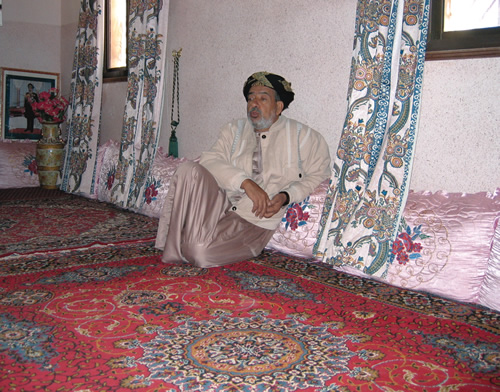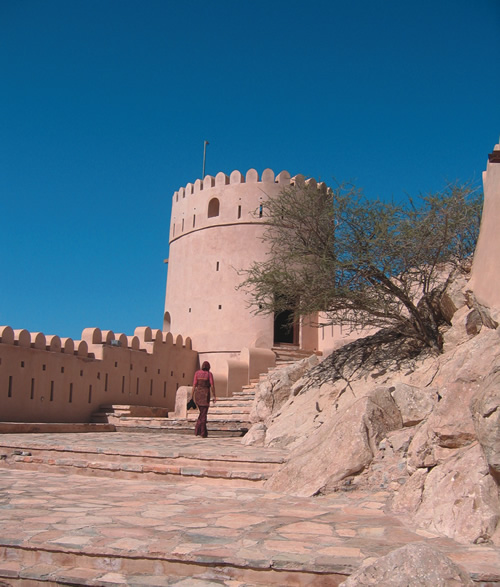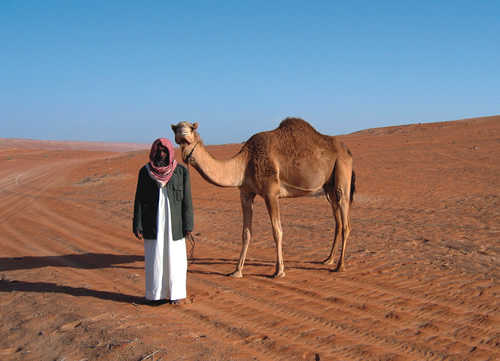Travel in Oman: The Other Middle East
Article and Photo by Alison Gardner
Senior Travel Editor

|
|
While visiting a mountain community, a spontaneous invitation from a retired military officer led the author and her guide, Saud, into this colorful sitting room where the host and his son served coffee and fresh
fruit snacks.
|
Street fighting, suicide bombers, dictatorial leaders holding the world hostage to increasingly expensive oil, women literally and figuratively behind a veil of oppression, and a language impossible to read or speak — all
are frequently associated by Westerners with Middle Eastern travel. The peaceable Sultanate of Oman is one example of a Middle Eastern country where these perceptions are not reality.
Oman is a slim 105,000-square-mile country about the size and population of Kansas, with a 1,000-mile coastline defining the strategic northeast flank of the Arabian Peninsula. Its modern history only began when 30-year-old
Sultan Qaboos Bin Said took the throne in 1970. Thirty-five years later his unwavering vision for social and economic opportunities for all — along with his patience and practicality have made him a beloved role model for the nation.
In 1970, Oman had 10 miles of paved road, no organized educational or healthcare system, and its fledgling oil economy was already faltering. During the ultra-conservative rule of Qaboos’s father, virtually all
ambitious Omanis had gone abroad to study, work, and live. The new Sultan immediately decided that if offered free universal education and healthcare, Omanis would come back home. At his invitation, they brought their skills, money, and
experience to help translate his vision into a workable reality.
In 2023, over 3 million citizens share an enviable prosperity, women have training and career opportunities equal to men, traditional culture and Moslem religious practices are honored, and international differences are
respected.
Visitors Are Welcome in Oman
Recognizing that oil will not be an income earner much longer, Sultan Qaboos has turned to tourism as a key revenue stream. Not surprisingly, he has chosen a woman to head the new Ministry of Tourism.
The country’s approach to tourism has been to identify and protect the naturally and culturally richest attractions, restore the most dramatic examples of pre-Islamic and early Moslem architecture, and
to focus on visitor access to ancient archaeological sites in a region where people have lived and traded for thousands of years. Virtually all areas of the country are now served by scheduled domestic flights and thousands of miles
of paved roads with spectacular off-road scenery.

|
|
Authentically restored pre-Islamic forts and castles are popular with both visitors and Omani citizens.
|
A Sample of Attractions
-
Numerous restored tribal forts and castles showcase historic furnishings, tools, and weapons.
-
Many of Oman’s desert Bedouin families invite visitors for coffee or even an overnight stay.
-
Over 400 species of birds make Oman one of the most spectacular feathery crossroads in the world.
-
In central Oman, only a few hours by car from Muscat, there are tent camps of varying sizes for visitors to enjoy a true desert experience (some more traditional and tranquil than others, so do your homework). Further
south and even more remote, Oman’s western border straddles the Arabian Peninsula’s infamous Empty Quarter (Rub al Khali) that can be sampled by camel or 4WD vehicle camping.
-
Marine mammal watching and scuba diving are rewarding activities, either aboard traditional wooden dhows or modern cruise vessels.
-
Conservation efforts may be fully appreciated by visiting major wildlife breeding reserves throughout Oman, including the Ra’s al Hadd Turtle Reserve, the Dimaniyat Islands Nature Reserve, and the Arabian
Oryx Sanctuary.

|
|
A Bedouin searching for fresh grazing for his camel is an increasingly rare sight in desert areas where four-wheel-drive vehicles are now each family’s main transport.
|
Challenges
Plane travel in such a long country is a necessity. Flights may not go daily, so advance planning is crucial. Between domestic flights in and out of the capital, Muscat, there are plenty of 1- or 2-day road trips into
the mountainous central region, to desert camps, or to coastal areas. Historic Muscat, population 500,000, offers a lot to see and do, including museums, the impressive national mosque, traditional markets (souqs) and cultural festivals.
While there is an abundance of high-end multi-national resorts and hotels with Western-style everything, inexpensive hotels and furnished apartments are difficult to locate and to book in advance.
Fortunately there is a growing number of government-sponsored hostels with furnished rooms and self-catering suites for all ages and family groups, located well away from main traffic areas. I was particularly impressed
by two new hostel complexes, one in Salalah and another near Areen Al Ashra on the central coast.
|
For More Info on Oman
There are plenty of inexpensive local Omani eateries in towns but not in villages, where people commonly eat at home. Once in the front entrance, every customer goes straight to the public sink area somewhere
in the back of the restaurant, washes hands and face, then goes to the front counter for a paper napkin to towel down. Tables and chairs in the front area are customarily occupied by men on their own or by foreigners, while Omani
families or women and children alone usually choose individual family rooms with a curtained door, colorful rugs, and cushions on the floor, often a TV in the corner, and possibly a shelf of toys and books for children. If in
mixed Omani company, I ate at a table out front without any protest or dirty looks from other customers. In the exclusive company of women, however, I happily slipped into a curtained room with equally good service.
Seasons: Visit Oman between October and April when temperatures are moderate. The south Salalah coast is drenched by monsoon rains from June to September, keeping it surprisingly green and
gorgeous.
In-country tour specialists: See a catalogue of operators and tourist information at Destination Oman.
The only outsider guidebook presently
available for Oman is Lonely
Planet's Arabian Peninsula. Consequently, its content
is understandably thin on each of eight countries. Several
guidebooks are published in Oman, so visit a bookstore soon
after arrival and browse for your favorite.
|
|
